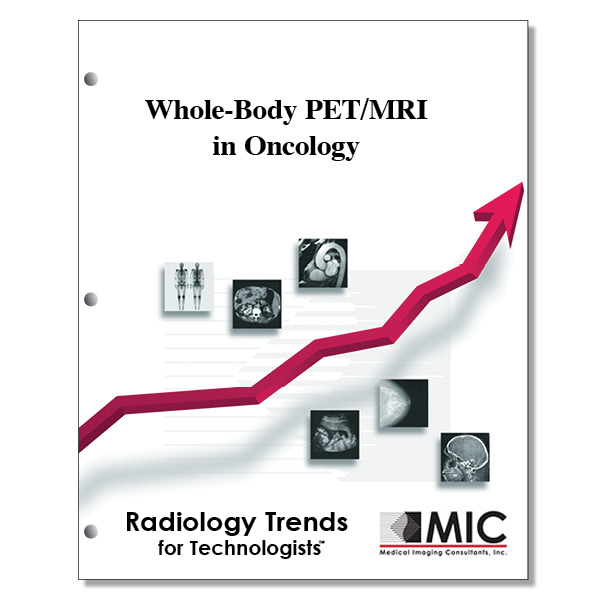

Whole-Body PET/MRI in Oncology
Whole-body PET/MRI protocols and requirements in oncology are reviewed.
Course ID: Q00390 Category: Radiology Trends for Technologists Modalities: MRI, Nuclear Medicine, PET, Radiation Therapy2.5 |
Satisfaction Guarantee |
$29.00
- Targeted CE
- Outline
- Objectives
Targeted CE per ARRT’s Discipline, Category, and Subcategory classification for enrollments starting after May 9, 2023:
[Note: Discipline-specific Targeted CE credits may be less than the total Category A credits approved for this course.]
Magnetic Resonance Imaging: 1.00
Patient Care: 0.50
Patient Interactions and Management: 0.50
Image Production: 0.50
Physical Principles of Image Formation: 0.25
Sequence Parameters and Options: 0.25
Nuclear Medicine Technology: 1.00
Patient Care: 0.50
Patient Interactions and Management: 0.50
Image Production: 0.25
Instrumentation: 0.25
Procedures: 0.25
Endocrine and Oncology Procedures: 0.25
Registered Radiologist Assistant: 1.00
Patient Care: 0.50
Pharmacology: 0.50
Procedures: 0.50
Abdominal Section: 0.25
Neurological, Vascular, and Lymphatic Sections: 0.25
Outline
- Introduction
- Workflow and Logistic Considerations
- Patient Preparation Before Examination
- In-Bed Patient Preparation
- Optimization of PET/MRI Protocols for Oncologic Indications
- General Aspects
- Potential PET/MRI Protocols for Whole-Body Oncologic Staging
- Data Visualization and Analysis
- Possible Artifacts on PET/MRI
- Conclusion
Objectives
Upon completion of this course, students will:
- understand the positioning of the PET detector ring for simultaneous PET/MRI
- know which vendors offer a trimodality PET/MRI system design
- know which vendors position the PET and MRI systems in the same room
- identify the indications for PET/MRI at a single bed position
- list the patient preparation requirements for the 18F-FDG PET portion of a PET/MRI study
- know the absolute contraindications for a PET/MRI study
- identify the MRI coils capable of transmitting RF energy
- identify the MRI coils capable of detecting signals from the body
- identify the characteristics of the body coil in the MRI system
- estimate the acquisition time per bed position for a simultaneous PET/MRI study
- list the technical aspects of a PET/MRI study that require measurement of the patient’s current physiological state
- list the tissue types that can be identified by the 2-point Dixon MRI sequence
- understand the usefulness of the 2-point Dixon sequence for anatomic localization of PET-positive lesions
- identify alternatives to the 2-point Dixon sequence for MRI attenuation correction
- list the indications where partial PET/MRI body imaging and region of interest imaging is warranted
- identify the MRI imaging sequence with the shortest acquisition time
- identify the MRI imaging sequences performed with the patient holding their breath
- recognize the MRI technique that is superior to 18F-FDG PET for detection of liver lesions smaller than 1 cm
- list the indications for which true whole-body PET/MRI should be performed
- list suggested techniques for overcoming the poor ability of MRI to detect small pulmonary nodules
- understand the effect of metallic implants on MRI images
- identify the body regions that can be affected by truncation of MRI datasets
- recognize the technique that helps reduce misregistration during PET/MRI studies
- understand the acquisition timing of MRI attenuation correction sequences
- identify the tissues that are ignored by current PET/MRI attenuation correction methods
- describe the reported SUV error rate from incorrect MRI-based attenuation correction
- describe the effect on SUV from tissue misidentification on MRI attenuation correction sequences
- identify the MRI system component responsible for spatial localization encoding of signals
- describe the characteristics of isotropic voxels
- list the MRI tissue saturation techniques used to nullify signal from fat
